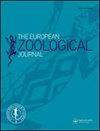Probing behavior of Aphis fabae and Myzus persicae on three species of grapevines with analysis of grapevine leaf anatomy and allelochemicals
IF 1.6
4区 生物学
Q2 ZOOLOGY
引用次数: 1
Abstract
Abstract The peach-potato aphid Myzus persicae (Sulzer) and the black bean aphid Aphis fabae Scopoli are polyphagous and cosmopolitan hemipterans, therefore they can infest grapevines in all areas of cultivation. Electrical Penetration Graph (EPG) technique was applied to monitor the probing behavior of A. fabae and M. persicae on Vitis amurensis Rupr., Vitis riparia Michaux, and Vitis vinifera L. The content of major flavonoids and stilbenoids in grapevine leaves and epidermal thickness, distance between abaxial leaf surface and phloem, and the simulated shortest pathway from epidermis to phloem that might have affected aphid probing were also analyzed. Aphid probing was limited mainly to non-vascular tissues on the three studied grapevine species. Phloem phase occurred in 32%, 14%, and 6% of A. fabae and in 76%, 39%, and 74% of M. persicae on V. amurensis, V. riparia and V. vinifera, respectively. Phloem phase consisted of only salivation into sieve elements and lasted less than 2.5 minutes on average in all aphids. The time to reach the first phloem phase on grapevines was 5.0 hours in A. fabae and 2.6–3.6 hours in M. persicae. Of the analyzed flavonoids, catechin, epicatechin, and quercetin occurred in all grapevine species, while rutin – in V. amurensis and V. riparia and isorhamnetin only in V. amurensis. Of the analyzed stilbenoids, piceid occurred in all grapevines, resveratrol in V. amurensis and V. vinifera, and ε-viniferin only in V. vinifera. Aphid behavior demonstrated that V. amurensis, V. riparia and V. vinifera are not attractive host plants to A. fabae and M. persicae. It is likely that the content of flavonoids and stilbenoids contributes to the limited susceptibility of the three grapevine species to A. fabae and M. persicae, while the observed slight differences in the anatomical structure of the leaves seem not significant in this context.用葡萄叶片解剖和化感物质分析探讨蚕豆蚜和桃蚜在三种葡萄上的行为
摘要:桃薯蚜(Myzus persicae, Sulzer)和黑豆蚜(Aphis fabae Scopoli)是多食性、世界性的半翅目昆虫,因此它们可以侵染所有栽培区域的葡萄藤。采用电穿透图(EPG)技术监测了蚕豆蚜和桃蚜对葡萄的探测行为。并分析了葡萄叶片中主要黄酮类化合物和二苯乙烯类化合物的含量、表皮厚度、叶片背面到韧皮部的距离以及表皮到韧皮部的模拟最短路径对蚜虫探测的影响。蚜虫的探测主要局限于三种葡萄的非维管组织。蚕豆和桃蚜分别有32%、14%和6%、76%、39%和74%的韧皮部期。所有蚜虫的韧皮部期仅由流涎组成,平均持续时间不超过2.5 min。在葡萄植株上,豆科达韧皮部第一阶段所需时间为5.0 h,桃科达2.6 ~ 3.6 h。所分析的黄酮类化合物中,儿茶素、表儿茶素和槲皮素均存在于所有葡萄品种中,而芦丁-仅存在于葡萄品种中,异鼠李素仅存在于葡萄品种中。在所分析的二苯乙烯类化合物中,杉木酸酯存在于所有葡萄中,白藜芦醇存在于葡萄和葡萄中,ε-乙烯酸酯仅存在于葡萄中。蚜虫的行为表明,紫叶蚜、滨叶蚜和葡萄蚜对蚕豆蚜和桃蚜没有吸引力。这可能是黄酮类化合物和茋类化合物的含量导致了三种葡萄品种对蚕豆蚜和桃蚜的有限敏感性,而观察到的叶片解剖结构的微小差异在这种情况下似乎并不显著。
本文章由计算机程序翻译,如有差异,请以英文原文为准。
求助全文
约1分钟内获得全文
求助全文
来源期刊

European Zoological Journal
Agricultural and Biological Sciences-Animal Science and Zoology
CiteScore
3.10
自引率
5.60%
发文量
80
审稿时长
30 weeks
期刊介绍:
The European Zoological Journal (previously Italian Journal of Zoology) is an open access journal devoted to the study of all aspects of basic, comparative and applied protozoan and animal biology at molecular, cellular, tissue, organ, organismal, population, and community-ecosystem level. Papers covering multiple levels of organization and integrative approaches to study animal form, function, development, ecology, evolution and systematics are welcome. First established in 1930 under the name of Il Bollettino di Zoologia, the journal now has an international focus, reflected through its global editorial board, and wide author and readership.
 求助内容:
求助内容: 应助结果提醒方式:
应助结果提醒方式:


